New picture posting and writing guidelines for fishing blogs and forums.
With the fish catching season upon us, it is critical that we now switch over to picture taking methods and methods of modifying pictures that will deter internet stalkers from determining where we are with our trophy fish. Not only that, we must phrase the information we put out on the internet so nobody knows where we are fishing.
It seems that the new trend in fishing is to keep fishing spots as secret as possible. I’ve decided to go along with this growing trend. I know this will be difficult for some of you to achieve, but it must be done for the good of all of us. If you ever have any questions, feel free to ask.
Along with not talking about spots any more, there is a whole new way of taking and manipulating pictures so as to not give away where you are fishing. Even a mere cloud in the sky or a lone tree on the shore, might be enough to tip off the hordes of fishermen that want your spot and will rape it of all fish if they find the location.
In the past you would simply take a picture, crop it nicely and post it on the internet. Pretty much like the example below.
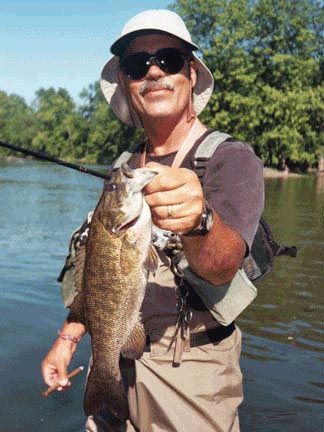
Well any idiot would know, based on the above picture, that I am fishing the Fox River in Batavia at Les Arends Forest Preserve. They would know that I am parked in the middle parking lot. They could then figure out that I am 150 yards up stream of the wheel chair ramp standing on the south edge of the chute of water that curves down and between a couple of islands. They would then know that I am fishing the edge of the chute where the bottom is made up of large limestone slabs that are bitch to wade through because they drop off sharply and if you’re not prepared it will send a jolt of pain all up and down your spine. They would then know that I was casting downstream a 4.5 inch pumpkinseed chartreuse Producto twister attached to a 1/16th ounce jig with a 2/0 hook and just letting it swim around in the current letting it bounce up and down and behind all this limestone. And they would know that I could feel the smallies pick it up and then let go, pick it up again, hold it and then give it a pop like popping down an olive. Then they would know that is exactly when I would set the hook.
Well, because from that one photo the average fisherman can tell all those things, and because there are tens of thousands of fishermen visiting local fishing blogs and forums looking for just those kinds of photos so they can go right to the spot, it is no longer recommended to put up photos like that. Below is an example of how the background can be completely eliminated to conceal where you are. All that the viewer will know is that you caught a nice fish, it was sunny out and you smoke cheap cigars. That is more than enough information for them to know.
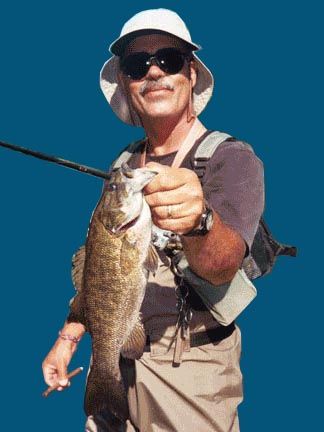
But let’s say you’re out by yourself and you still want to get a decent picture. First is to shoot down at the fish as you hold it by its jaw with its tail just barely out of the water. This way the background is nothing but water.
Second is to crop the image of the fish closely in Photoshop.
Both these methods conceal most of the background of where you were fishing. But you have to be careful using this technique. If you are in water that I’ve fished, I’ve memorized miles of shoreline and river bed. Something so simple as that tree in the background, or that rock in the water, might be recognizable by guys like me. You can bet I’ll be out there the next day, in your spot, trying to hook every fish in the area. I’m sure there are thousands of guys on fishing blogs and forums waiting to do that exact same thing.
A third technique is to get in extremely tight on the fish. This way the background is pretty much completely gone, we can see what kind of fish it was and you can just tell us how long and/or heavy it was and we’ll believe you. Following are some examples of this technique.
Again, you have to be careful. In the first picture of the largemouth bass, I can see reflections of trees in its skin. That might be all the internet stalker needs to know where you were.
Finally, there is the most preferred method. It blocks out the background, but lets the viewer see the fish in its entirety. AND the extra benefit is that it conceals the identity of the person holding the fish. There is nothing worse than being out on the water and someone recognizes you. The next thing you know there will be a convoy of cars following you all up and down the river.
Here are three example of the picture manipulation method I’m describing.
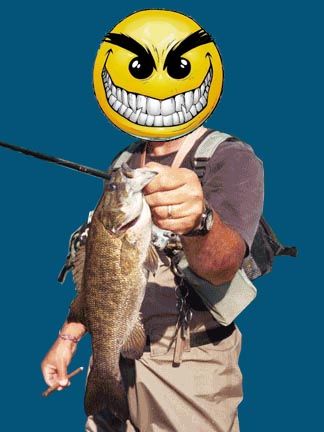
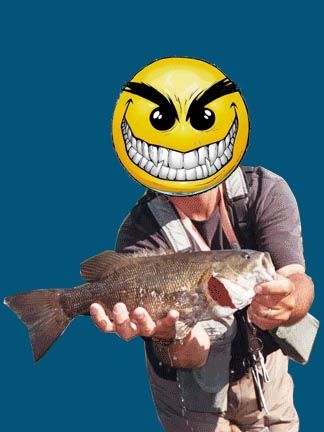
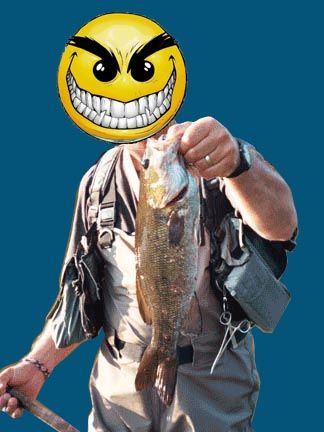
While giving fishing reports that go along with your pictures, you have to remember to be as vague as possible. An example:
“I was fishing flowing water.”
That’s enough information. There’s no need for descriptions of your surroundings. That could tip off a few thousand fishermen as to your whereabouts.
All of this is extremely important, there are hundreds, if not thousands, of fishermen willing to follow and stalk the successful fisherman out there that is leaving their images on fishing blogs and forums.
I am not making this up.
So, I have yet to decide whether these new guidelines should be a rule that all of us should follow, or just keep them as suggestions. All I know is that if you post a lot of details on a fishing blog or forum, and hundreds of thousands of fishermen look at those details and go looking for your spot, don’t come here whining and bitching when you go to your spot and it looks like this.
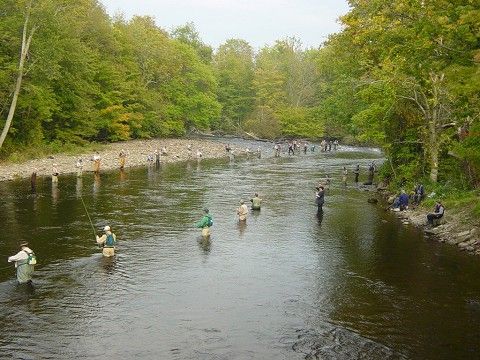
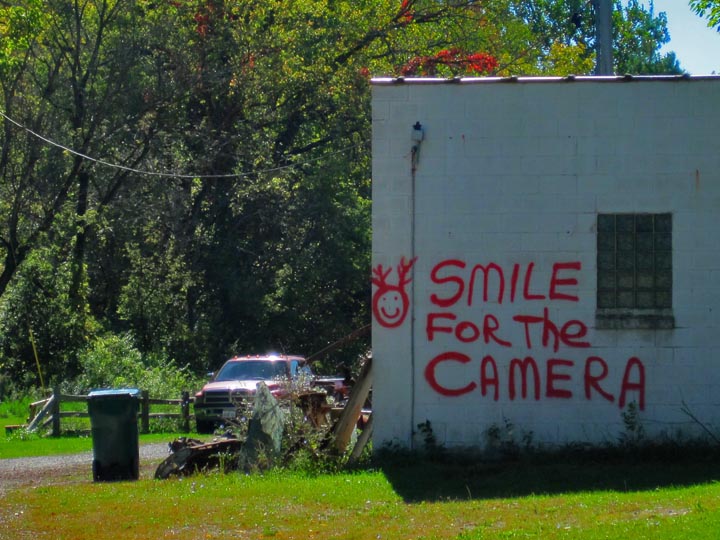
Clif
3 May 2011One picture is risky, two is a taunt but three is down right stupid. Triangulation is likely should the wrong person see.
Owl
3 May 2011Ok, you got me on this one…I have to comment. I have to tell you that it’s a great read and on top of that, something very near and dear to my heart. Not because I go over-the-top in hiding where the fishing is, but because last fall someone posted a photo of a trout and in the background were three rocks and a tree. I recognized the place by the rocks and emailed the angler to find out if I was right. I was. But really…what are the odds? That’s the one and only time I’ve done that in over a decade of looking at local fish pics online. You know, even a blind pig….or fat squirrel…oh whatever that saying is….
Ken G
4 May 2011I’m known around here for giving away my spots, but since I switched to more remote areas, I give them away and never see anyone. Part of me understands, part of me likes to make fun of it, a lot. I do recognize trees and rocks in some areas I’ve fished a lot. It’s a curse.
Since it’s a lot more urban around here, the landmarks are much easier to locate. But, there’s a big difference in knowing where to fish and how to fish it once you get there.
Reading your site and the other trout fly guys from OBN has me back on the creeks around me. Granted, it’s creek chubs and smallies, but you take what you can get 🙂
Nina G
4 May 2011Could not stop laughing…in public. It was embarrassing but I love it. Careful, they might start recognizing the fish because of the 4 missing scales on the left side closest to the tail…
Ken G
4 May 2011I wrote this over two years ago, but it was buried on my forum. Which nobody reads 🙂
I should put up that picture of the reflection in Leah’s eye. That’s a cool shot.
Raptor
5 May 2011Great… -now EVERYONE knows that there are smallies in the Fox River.
Way to go Ken.
I suppose next, you going to get into sauger fishing, and spill the beans about the Illinois River…
You should take up golf.
The only use that I have for golf, is that it keeps hoardes of the unworthy from discovering SMALLMOUTH BASS FISHING!
Ken G
5 May 2011I’ve decided to start targeting carp, quillbacks, suckers and creek chubs.
So the smallies are safe.
SAUGERS, why eat those when you can go for the trophy walleye.